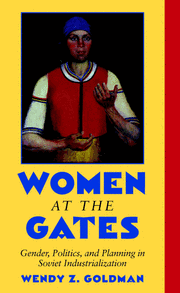Book contents
- Frontmatter
- Contents
- Acknowledgments
- List of Illustrations
- List of Tables
- Acronyms and Abbreviations
- Women at the Gates
- Introduction
- 1 Guarding the Gates to the Working Class: Women in Industry, 1917–1929
- 2 The Struggle over Working-Class Feminism
- 3 The Gates Come Tumbling Down
- 4 From Exclusion to Recruitment
- 5 “The Five-Year Plan for Women”: Planning Above, Counterplanning Below
- 6 Planning and Chaos: The Struggle for Control
- 7 Gender Relations in Industry: Voices from the Point of Production
- 8 Rebuilding the Gates to the Working Class
- Conclusion
- Index
- Plate Section
1 - Guarding the Gates to the Working Class: Women in Industry, 1917–1929
Published online by Cambridge University Press: 30 July 2009
- Frontmatter
- Contents
- Acknowledgments
- List of Illustrations
- List of Tables
- Acronyms and Abbreviations
- Women at the Gates
- Introduction
- 1 Guarding the Gates to the Working Class: Women in Industry, 1917–1929
- 2 The Struggle over Working-Class Feminism
- 3 The Gates Come Tumbling Down
- 4 From Exclusion to Recruitment
- 5 “The Five-Year Plan for Women”: Planning Above, Counterplanning Below
- 6 Planning and Chaos: The Struggle for Control
- 7 Gender Relations in Industry: Voices from the Point of Production
- 8 Rebuilding the Gates to the Working Class
- Conclusion
- Index
- Plate Section
Summary
In the 1920s, the male labor force poured in from the countryside and began to replace women in production. This frequently occurred under the banner of “rationalization,” but in fact, one group was laid off and another hired.
S. Gimmel'farb, planner and labor expertWomen fared badly in the mass layoffs on the railroads. When men and women held the same job, women were the ones to be laid off. There was a definite tendency to lay off women whose husbands were working.
1929 report on union work among women employed on the railroadsAt the end of the 1920s, a poor peasant woman named Zaminskaia was abandoned by her husband. Left to fend for herself and her two children, she went to the city in search of work. She tried to register at the labor exchange, which dispensed both jobs and unemployment benefits, but was told she was eligible for neither. “You must first work six months for wages,” an official explained. Feeling increasingly hopeless, she ran from one state agency to another, from the Department of Labor to the local soviet to the Workers’ and Peasants’ Inspectorate. She heard the same story from every official. Without previous work experience, she could not register to work. Finally she wrote a despairing letter to Rabotnitsa, a journal for women workers. “I am sick and I am starving,” she noted. “I have appealed everywhere.”
- Type
- Chapter
- Information
- Women at the GatesGender and Industry in Stalin's Russia, pp. 5 - 32Publisher: Cambridge University PressPrint publication year: 2002
- 1
- Cited by



